
Some Observations on Relocating Tropical Trees
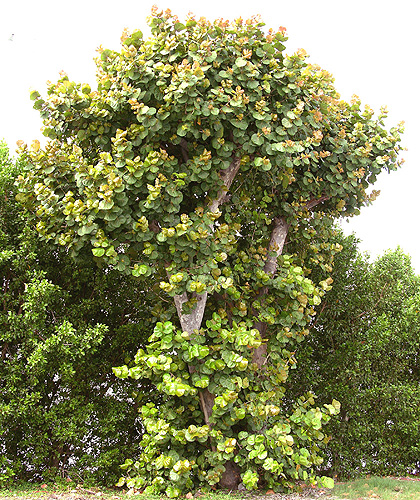
Reprinted from:
City Trees: Journal of the Society of Municipal Arborists
www.urban-forestry.com
July 2007
Recently I visited a job site where large tropical specimen trees had been relocated two years ago, a year before construction began. I know the trees were properly moved by competent professionals, because I met the team and was able to observe the trees immediately after the move. What surprises me now when I visit the site is the amount of damage to the trees that has occurred since the relocation.
Hiring experienced professionals to relocate specimen trees is very important to the ultimate survival of those trees. What is just as important, or perhaps even more so, is the pre-relocation and post-relocation care of the trees. The pre-relocation care ensures that the trees are in the best condition, have recovered and responded well to the root pruning, and are ready to be relocated. The post-relocation care is perhaps the most critical time of the move. At this time, the tree is under stress and will not be able to respond to damage in the same manner as it would in its most healthy and vigorous state.
I recognize that the key to all of this is the bottom line—the budget and those that are in charge of the budget. But most owners and developers are not aware that their costly investment in the relocation of specimen trees is not necessarily assured without long-term care. Often “value engineering,” or cost reduction, interferes with the long-term care that is necessary to the survival of these trees.
Pre-relocation CareRoot-pruning by backhoe is much cheaper than root-pruning by hand, but the results are never the same. The danger of pulling and tearing out roots at the trunk using a large piece of equipment is high, and the resulting damage to the trunk can be fatal. When roots have been torn away from the trunk, rot will likely occur. My observation—and this includes palm trees—has been that even if the rot is compartmentalized in time, the tree may become structurally unsound and hazardous.
I always suggest root pruning by hand to ensure roots are cut cleanly. Roots compartmentalize damage the same way as branches and trunks, and they require a clean cut. In addition, do not let the tree dry out. Make sure the roots of the tree are irrigated on a regular basis and just before relocation. A moist root ball is heavier—thereby requiring larger equipment—but will be better equipped to survive the relocation.
Methods of Moving Large Tropical TreesThere are three primary methods for relocating trees: building a container around the root system and picking it up; pinning the tree by drilling a hole through the trunk and inserting a steel pin that will be utilized as a pick-up point; or rigging the branches and/or trunk with straps. In my opinion, picking up root containers is the best way to move large trees. Expense is the major disadvantage.
One advantage of the second method, pinning the trunk, over straps is that the branches do not have to bear the stress of picking up the tree. However, we know that wounds close—they don’t heal. The wood that was exposed to the drill and any stressed wood surrounding the pin will never be restored to its original health. One hopes for optimum compartmentalization by the tree’s natural immune system so fungi and pathogens can’t spread very far into sound wood, but there is the possibility that the tree will become hazardous in time.
The third method, strapping a tree trunk or several branches for pickup, is perhaps the most common (and cheapest) method of rigging large trees for moving. I have seen trees weighing up to 80 tons picked up by the branches (in this instance, at four points) and eventually recover and thrive in their new location. There is a problem, however: trunk compression from the strap.
Different species of tropical trees react differently to trunk compression. In some cases, I attribute immediate damage to poor rigging, but some species simply do not tolerate straps, especially over a certain total tree weight. Other species seem to resist compression from strapping initially—the bark is intact when the straps come off—but show damage two to three years later. Depending on the tree species and the way it was strapped, this damage can result in rot and disease in the main trunk and/or total branch loss.
Post-relocation CareLarge specimen tropical trees can be relocated successfully, but the horticultural care required in the subsequent two years is critical. Trees are very vulnerable on construction sites due to equipment damage and soil compaction. Also, when trees are moved onto active construction sites, they are sometimes planted at a higher grade until construction is completed and the surrounding grade is raised. Those trees, basically planted on a mound, can dry out fast. In tropical areas or any area with high temperatures, keeping the root ball well irrigated can be very difficult. But if a newly planted tree keeps drying out, stress will be a constant factor, and insects and other pathogens will have a better opportunity to attack the tree.
When working in areas prone to hurricanes or typhoons, braces and other supports must be removed just before the winds hit, so the tree can blow over unencumbered. I have observed that if the braces or stakes are left on, trees may snap off. But among tropical trees, blow-downs can be promptly replanted and often recover well.
The cost involved in the relocation of a large tree can be substantial. But the alternative, if “value engineering” wins the day, is more costly: at least, wasted effort and at worst, a hazardous tree that could eventually cause damage to life and property.
Story and photos by Jeff Shimonski, Certified Municipal Arborist & Director of Horticulture, Parrot Jungle Island
Photo Gallery
Click Photos to Enlarge
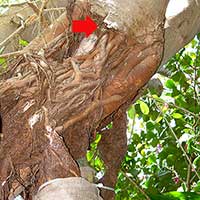 Bo Tree (Ficus religiosa) arrow indicates 5 yr old compression damage from a tree strap. Aerial roots on the Bo tree began to grow over the damage two years ago and are now being trained to a pole to create an extra trunk for stabilization during hurricanes.
Bo Tree (Ficus religiosa) arrow indicates 5 yr old compression damage from a tree strap. Aerial roots on the Bo tree began to grow over the damage two years ago and are now being trained to a pole to create an extra trunk for stabilization during hurricanes.
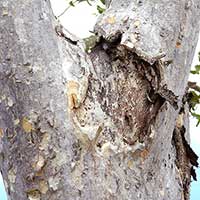 This arjuna tree (Terminalia arjuna) was moved two years ago, the arrow shows the resulting compression damage from tree straps.
This arjuna tree (Terminalia arjuna) was moved two years ago, the arrow shows the resulting compression damage from tree straps.
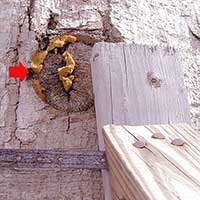 The arrow show the hole where a steel pin was inserted through the trunk of a kepoh tree (Sterculia foetida) two years ago. Also shown are nails that have been hammered into the tree to attach braces. Cambial dieback and rot are likely due to these deep holes in the trunk-a potential hazard tree even with the callus forming around the larger hole.
The arrow show the hole where a steel pin was inserted through the trunk of a kepoh tree (Sterculia foetida) two years ago. Also shown are nails that have been hammered into the tree to attach braces. Cambial dieback and rot are likely due to these deep holes in the trunk-a potential hazard tree even with the callus forming around the larger hole.
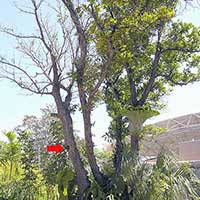 Relocated five years ago with rigging from three tree straps, this kamani tree (Calophyllum inophyllum) shows the kind of damage that can occur from trunk compression. The arrow shows where the strap was attached and compression occured. The entire trunk will have to be removed.
Relocated five years ago with rigging from three tree straps, this kamani tree (Calophyllum inophyllum) shows the kind of damage that can occur from trunk compression. The arrow shows where the strap was attached and compression occured. The entire trunk will have to be removed.


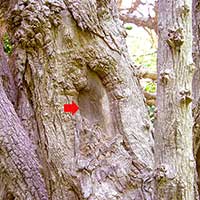
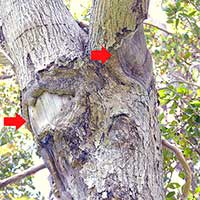

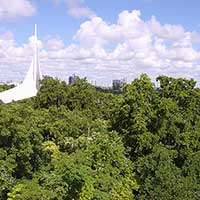
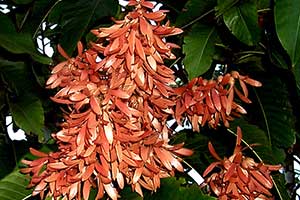 About Tropical Trees & Arboriculture
About Tropical Trees & Arboriculture An Experiment in Arboriculture and Mosquito Control
An Experiment in Arboriculture and Mosquito Control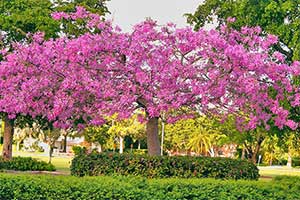 Ceiba Speciosa
Ceiba Speciosa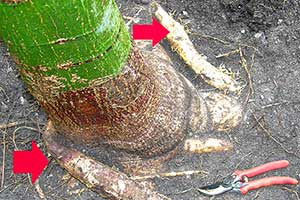 Why Trees Blow Over
Why Trees Blow Over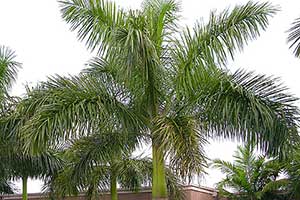 Royal Palm Bugs
Royal Palm Bugs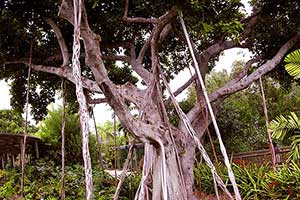 Ficus Species & Hurricane Horticulture
Ficus Species & Hurricane Horticulture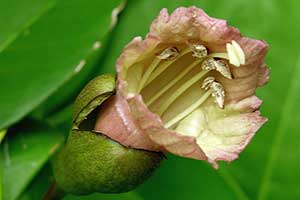 Pollination and the Natural History of the Calabash Tree
Pollination and the Natural History of the Calabash Tree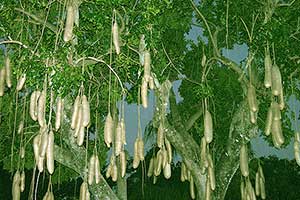 Pollinating Sausage Trees
Pollinating Sausage Trees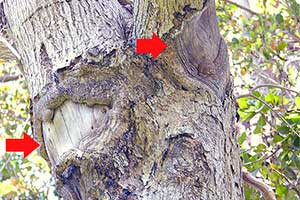 Some Observations on Relocating Tropical Trees
Some Observations on Relocating Tropical Trees